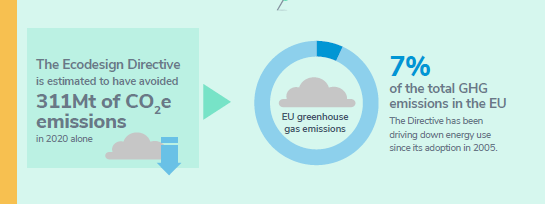Sustainable Products Initiative – A reviewed Ecodesign Directive under way, how to ensure it is fit for purpose?
The European Commission gears up to launch its Sustainable Products Initiative (SPI) on 30 March, including a revision of the Ecodesign Directive. What are the make-or-break aspects to look out for?

Since its first adoption in 2005, the Ecodesign Directive has not only massively improved the energy efficiency, but also the overall environmental performance of energy-related products, including a wide range of common appliances, such as washing machines or screens. However, today the Directive faces many issues: powerful industrial lobbies weakening the requirements and slowing down the process; a lack of resources provided by the Commission; important delays in the implementation of the measures; poor enforcement; and free riders undermining further savings.
With the ambition to make all products more sustainable, the European Commission now intends to extend the scope of the Directive beyond energy-related products. This requires a major rethinking of this legal instrument. In our view, the revamped framework should not only keep delivering on circularity and energy-efficiency, but also follow a life-cycle approach and mandate requirements linked to environmental and social aspects.
The SPI will be successful if it includes…
- Ambitious and timely legal requirements. The revised ecodesign framework should remain ambitious and not compromise on hard-won achievements in the energy field. The implementation of product-specific minimum design measures under the SPI should not suffer from further delays. Voluntary agreements should no longer be a possibility, as the existing self-regulatory measures have fallen short in ambition.
- High sustainability standards and transparent information. Measures covering the full life-cycle of products should address performance and durability requirements, to ensure that the most low-carbon, non-toxic, resource-efficient and long-lasting products become norm. Minimum environmental performance requirements must ensure that environmentally damaging products are removed from the market. This should be accompanied by mandatory, transparent and accessible information requirements through the introduction of a digital product passport.
- Inclusive consultation process. The law should ensure that stakeholders, including civil society, are consulted during the development of preparatory studies that lead to the introduction of implementing measures, are part of the Consultation Forum, and participate in the development of the multi-year working plans which establish priority product groups to be regulated.
- A comprehensive scope and a full life-cycle approach, starting at the design phase. The extended scope of the revised framework should influence product legislation generally to mainstream circularity and cover the whole value chain of products, including
supply chain and end-of-life, and its carbon footprint. Definitions should be clear, forward-looking, and free from loopholes. - Product assessment methodologies. The methodology used for the assessment of the environmental impact of each product group before legal requirements are drawn up should be updated. Evaluations should consider all environmental and social externalities to define environmental hotspots that go beyond the use phase only. The currently used ‘least life-cycle cost’ criterion, that only looks at energy efficiency gains that can pay back quickly, should be replaced with a criterion where environmental savings are maximised. Since its first adoption in 2005, the Ecodesign Directive has not only massively improved the energy efficiency, but also the overall environmental performance of energy-related products, including a wide range of common appliances, such as washing machines or screens. However, today the Directive faces many issues: powerful industrial lobbies weakening the requirements and slowing down the process; a lack of resources provided by the Commission; important delays in the implementation of the measures; poor enforcement; and free riders undermining further savings.
The SPI will be too weak if…
It fails to secure hard-won achievements for energy-related products, and to expand its scope to other types of products.
- It does not address the shortcomings of the existing product legislation (such as the Construction Products Regulation and the Packaging and Packaging Waste Directive).
- It makes room for industrial voluntary agreements, which will fail to deliver on both climate and circular economy objectives. Current and past experiences have clearly demonstrated the limits of the self-regulatory approach.
• Its environmental performance and durability requirements are too weak.
• It does not require that accessible and transparent information is given to relevant circular economy actors.
Did you know that…?

A strong SPI is a once-in-a-decade opportunity to make sustainable products the norm!

 By
By 
